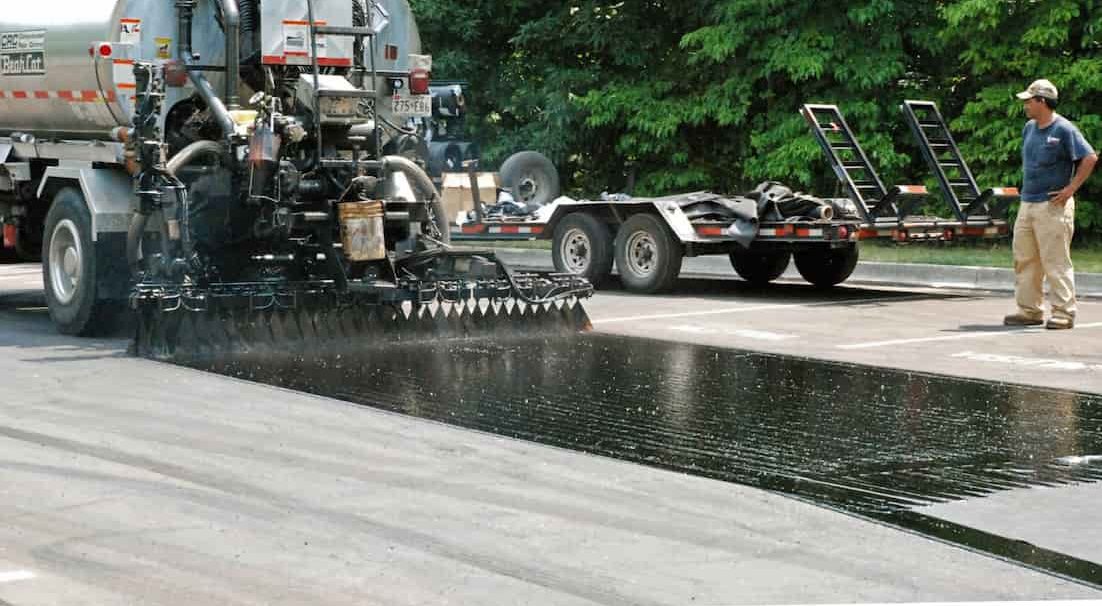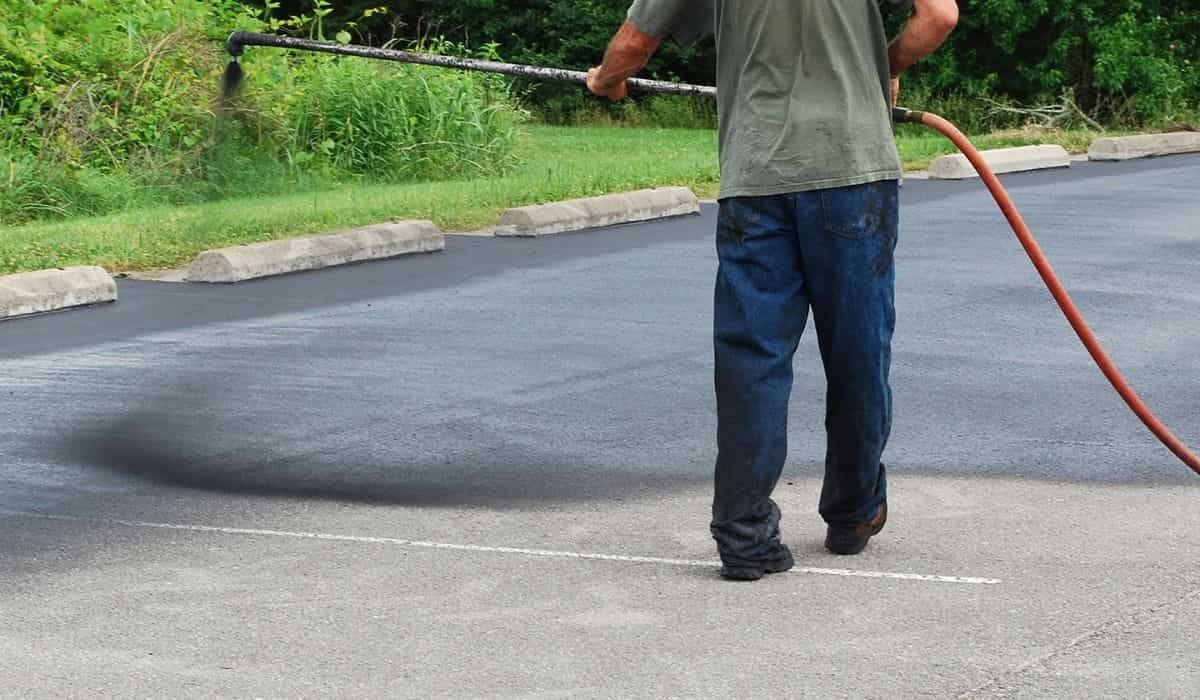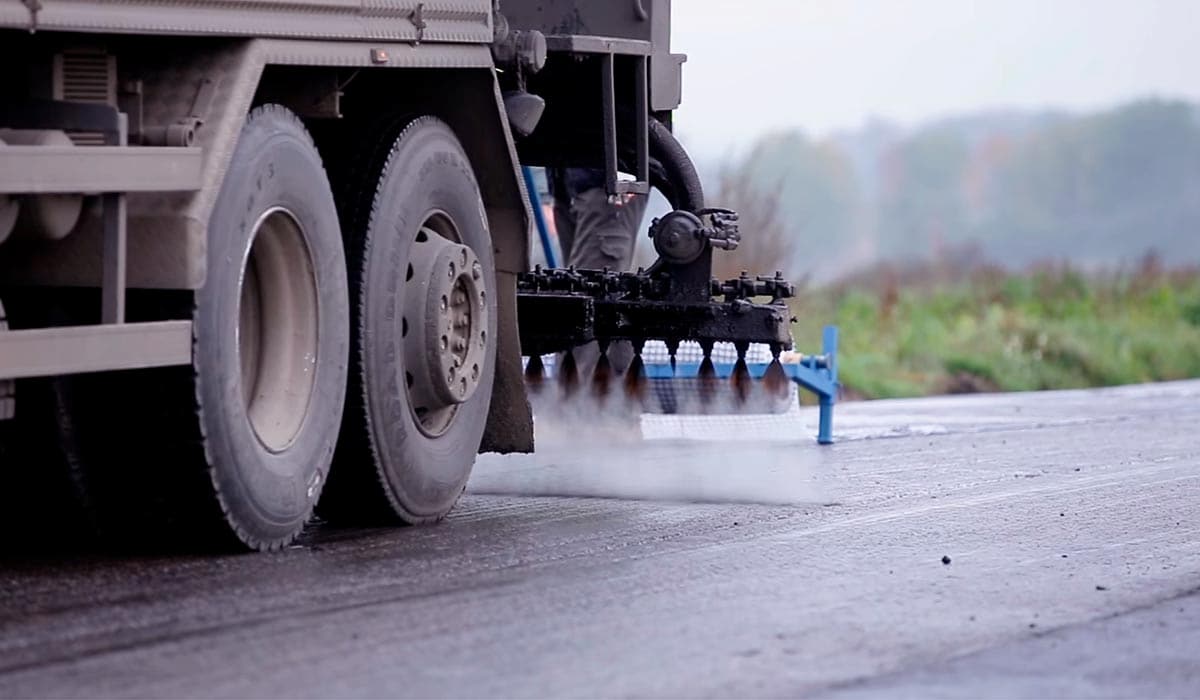Tack coats are thin layers of bituminous liquid asphalt, emulsion, or cutback asphalt used to promote adhesion between HMA pavement lifts. The main application of this material is bonding between construction lifts, especially between the current road surface and an overlay, which is essential for the completed pavement structure to work as a single unit and provide sufficient strength. If adjacent layers are not connected, they act as a collection of independent, thin layers, none of which are designed to withstand the bending stresses caused by traffic. Inadequate layer bonding can result in delamination, which can lead to longitudinal wheel path cracking, fatigue cracking, potholes, and other distresses such as rutting, which all drastically reduce pavement life. The tack coatings should be applied evenly across the whole pavement surface, resulting in surface coverage of roughly 90 percent. To achieve this uniformity on a consistent basis, each component of the application must be rigorously examined and regulated. Specific features include the condition of the tack-coated pavement surface, the application rates, and diluted tack coating. The pavement surface getting the tack coat should be clean and dry for best adhesion. On cool and/or damp pavement, emulsified tack coat materials can be applied; however, the needed setting time may increase.  Existing and milled pavements can be quite dirty and dusty; therefore, their surfaces must be cleaned by sweeping or washing before any tack coat is applied; otherwise, the tack coat material may adhere to the dirt and dust instead of the adjacent pavement layers. This can result in excessive tracking of tack coat material. The tack-dirt mixture is transported on the tires of construction vehicles and equipment, leaving the existing roadway with little or no tack coat in the wheel pathways. When cleaning is insufficient, slippage, cracking, and delamination are commonplace. The application of tack coat should yield a thin, uniform layer of tack coat material covering approximately 90 percent of the pavement surface. To achieve this objective, the application rate will vary based on the condition of the pavement receiving the tack coat. Inadequate adhesion between layers can result from employing an insufficient amount of tack coat. Too much tack coat can provide a lubricated slipping plane between layers or allow the tack coat material to be drawn into an overlay, so altering the mix properties and perhaps producing bleeding in thin overlays.
Existing and milled pavements can be quite dirty and dusty; therefore, their surfaces must be cleaned by sweeping or washing before any tack coat is applied; otherwise, the tack coat material may adhere to the dirt and dust instead of the adjacent pavement layers. This can result in excessive tracking of tack coat material. The tack-dirt mixture is transported on the tires of construction vehicles and equipment, leaving the existing roadway with little or no tack coat in the wheel pathways. When cleaning is insufficient, slippage, cracking, and delamination are commonplace. The application of tack coat should yield a thin, uniform layer of tack coat material covering approximately 90 percent of the pavement surface. To achieve this objective, the application rate will vary based on the condition of the pavement receiving the tack coat. Inadequate adhesion between layers can result from employing an insufficient amount of tack coat. Too much tack coat can provide a lubricated slipping plane between layers or allow the tack coat material to be drawn into an overlay, so altering the mix properties and perhaps producing bleeding in thin overlays. 
bituminous emulsion
A bituminous emulsion is a tiny droplet-sized combination of bitumen and water. Bitumen does not mix with water because it is a petroleum product, and its stickiness prevents it from dissolving into little droplets. An emulsifier is utilized to solve this problem. A surface-active material is referred to as an emulsifier. The emulsifier keeps the bitumen in droplet form by preventing it from combining with other droplets. The drops float in the water because they are so little. Bitumen emulsion is thus a liquid dispersion made up of three components: water, bitumen, and emulsion. The bitumen emulsion is classified into two types. Depending on the Surface Charge and Setting Time When bitumen emulsion is applied to aggregate for road construction, water evaporates, leaving behind bitumen droplets. These droplets spread across the aggregate, interact with one another, and finally combine to form a strong structure. Bitumen emulsion is further classified into three types based on setting time, which is determined by the amount of time it takes for the vitamin emulsion to evaporate and the particles to separate from the water. Slow curing : A specific emulsifier is used in this type of emulsion to decrease water evaporation. This sort of emulsifier is relatively stable.  Medium curing: This type of bitumen emulsion does not separate when applied to aggregate. When fine mineral dust is blended with the aggregate emulsion mixture, the evaporation process commences. Rapid curing: This type of bitumen emulsion degrades quickly when it comes into touch with aggregate, allowing for faster setting and curing. Bitumen is also classified into two other categories of Cationic Bitumen Emulsion and Anionic Bitumen Emulsion based on surface charge. While the minuscule bitumen droplets in anionic bitumen emulsion are electronegatively charged, in cationic bitumen emulsion, the microscopic bitumen droplets are electro-positively charged. Cationic between emulsions are the most common and widely used form of bitumen. The mineral content of the aggregate influences the choice of positive or negative recharging between emulsions. For example, because the surface of silica-rich aggregates is positively charged, cationic bitumen emulsion is used to aid and help in the spreading and binding of bitumen with aggregates.
Medium curing: This type of bitumen emulsion does not separate when applied to aggregate. When fine mineral dust is blended with the aggregate emulsion mixture, the evaporation process commences. Rapid curing: This type of bitumen emulsion degrades quickly when it comes into touch with aggregate, allowing for faster setting and curing. Bitumen is also classified into two other categories of Cationic Bitumen Emulsion and Anionic Bitumen Emulsion based on surface charge. While the minuscule bitumen droplets in anionic bitumen emulsion are electronegatively charged, in cationic bitumen emulsion, the microscopic bitumen droplets are electro-positively charged. Cationic between emulsions are the most common and widely used form of bitumen. The mineral content of the aggregate influences the choice of positive or negative recharging between emulsions. For example, because the surface of silica-rich aggregates is positively charged, cationic bitumen emulsion is used to aid and help in the spreading and binding of bitumen with aggregates. 
bituminous emulsion application
The bituminous emulsion is currently utilized in a wide range of road construction applications, including gravel coats, gravel roads, asphalt road toppers, and dust binding on dirt roads. This road construction material can also be utilized for patch repairs, cold storage mix preparation, surface treatment, thin protective layers, cold emulsion-mineral mixtures, and tack coats. The applications of bitumen emulsion extend beyond road building and maintenance. This substance is also used for ground permeation, concrete structure protection, metal surface coating, electro and thermal insulation materials, waterproof cardboard production, sand grouting, soil insulation, and waterproofing, among other applications. Popular because the bitumen in the emulsion does not need to be heated, giving it a significant benefit over alternatives that require heating. Historically, bitumen emulsions have produced the best results for cold road construction and maintenance. Tack coat: Tack coat is the most common application of bitumen emulsion. The asphalt mixture is sprayed with a thin emulsion coating to ensure that it clings securely to the underlying layers. This layer is necessary for the vast majority of roadways. A variety of styles exist for tack coatings.  Surface treatment: Surface treatment is utilized for the application of new asphalt coatings, recycled asphalt coatings, enhanced vehicle traction on the road surface, and extended road life. The surface coating renders the road surface impermeable, textured, dense, and wear-resistant. Gravel impregnation: To build multilayer surfaces using gravel of varied sizes, it must be crushed and impregnated with a 50-65 percent bitumen-based emulsion that settles slowly. Patch repair: As previously stated, there are numerous advantages to using bitumen emulsions over hot bitumen. The flexibility to utilize it from early spring to late fall in temperatures as low as 5oC is one of its advantages. Additionally, the use of emulsion facilitates the use of moist materials. The rate of application for patch repairs is between 1.3 and 1.6 liters per square meter per centimeter of patch depth. Additionally, bitumen emulsion can be utilized to repair surface fissures. The material is mixed with fine sand and used to plug fractures several millimeters below the surface. After the mixture has solidified, the remaining centimeters are filled with emulsion in their purest form. The surface of the patch is covered with sand to prevent its deterioration.
Surface treatment: Surface treatment is utilized for the application of new asphalt coatings, recycled asphalt coatings, enhanced vehicle traction on the road surface, and extended road life. The surface coating renders the road surface impermeable, textured, dense, and wear-resistant. Gravel impregnation: To build multilayer surfaces using gravel of varied sizes, it must be crushed and impregnated with a 50-65 percent bitumen-based emulsion that settles slowly. Patch repair: As previously stated, there are numerous advantages to using bitumen emulsions over hot bitumen. The flexibility to utilize it from early spring to late fall in temperatures as low as 5oC is one of its advantages. Additionally, the use of emulsion facilitates the use of moist materials. The rate of application for patch repairs is between 1.3 and 1.6 liters per square meter per centimeter of patch depth. Additionally, bitumen emulsion can be utilized to repair surface fissures. The material is mixed with fine sand and used to plug fractures several millimeters below the surface. After the mixture has solidified, the remaining centimeters are filled with emulsion in their purest form. The surface of the patch is covered with sand to prevent its deterioration. 
bituminous tack coat
A bituminous tack coat, also known as a bond coat, is a thin layer of asphalt emulsion applied between layers of hot mix asphalt to create a strong, slip-resistant adhesive bond. Under porous layers or around holes, where the substance can also function as a sealant, thicker coatings may be used. Without tack coat, the asphalt layers of a road may separate, so reducing the road's structural integrity and perhaps allowing water to penetrate the structure. Moreover, the road may become less secure. Depending on the country in which they are produced, tack coatings can be formulated using a variety of emulsions. In the United States, it is customary to dilute an emulsion that sets slowly with water before applying it. In a number of European nations, undiluted cationic rapid setting emulsions or specially formulated low viscosity medium setting emulsions are utilized. These cationic emulsions may have a slow or moderate setting time. Additionally, a prime coat is applied before a tack coat. This serves two purposes: protecting the foundation and enhancing the asphalt's ability to adhere to itself. As opposed to a tack coat, it can be produced using asphalt oil or a specialized emulsion.  Prime coats maintain the structural integrity of the granular base and help prevent dust during the construction process. In the case of a base that is to be covered with a thin hot mix layer or a chip seal for a low-volume roadway, priming ensures a strong bond between the seal and the underlying surface. Without priming, the seal and the surface beneath it would tend to separate. Emulsion primes are more environmentally friendly than cutback asphalt primes. The environmental impact of emulsion primers is reduced. Prior to application, it is best to dilute a slow-setting asphalt emulsion with water in order to achieve the desired results. In the case of dense granular bases or stable bases, it may be necessary to scarify the surface prior to application to ensure adequate penetration. This can be achieved by fragmenting it. For more information regarding bitumen and bituminous products, feel free to contact us. Our professional and trained sales executives are ready to answer all your questions and guide you through the purchase process.
Prime coats maintain the structural integrity of the granular base and help prevent dust during the construction process. In the case of a base that is to be covered with a thin hot mix layer or a chip seal for a low-volume roadway, priming ensures a strong bond between the seal and the underlying surface. Without priming, the seal and the surface beneath it would tend to separate. Emulsion primes are more environmentally friendly than cutback asphalt primes. The environmental impact of emulsion primers is reduced. Prior to application, it is best to dilute a slow-setting asphalt emulsion with water in order to achieve the desired results. In the case of dense granular bases or stable bases, it may be necessary to scarify the surface prior to application to ensure adequate penetration. This can be achieved by fragmenting it. For more information regarding bitumen and bituminous products, feel free to contact us. Our professional and trained sales executives are ready to answer all your questions and guide you through the purchase process.

0
0